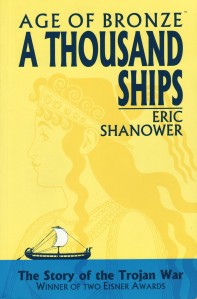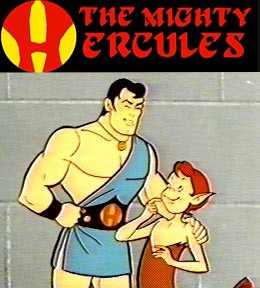I don’t like demigods cavorting with superheroes.
Yes, Chris Hemsworth plays a hunky Thor, and Hercules had a perfectly respectable stint as an Avenger in the 60s. I didn’t even object when he went on to anchor the now forgotten Bronze Age team The Champions. But the argument that superheroes are just the latest issue of ancient mythology doesn’t do it for me.
Not that it’s a bad argument. Etymologically, “superhero” comes from Shaw’s “superman” which comes from Nietzsche’s “ubermensch” which comes from Goethe’s “unbermenschen” which is translated “superhuman” or “demigod” (though only in a mathematical sense can “greater-than-human” mean “less-then-god”). Semantics aside, comic book mythology, despite all those earthbound gods, is a lot more than antiquity in spandex.
Which is one in a long list of reasons to admire Eric Shanower’s The Age of Bronze. The meticulously researched, multi-book interpretation of the Trojan War is a trove of source materials, from archaeological to Shakespearean, all compiled, sifted, rewoven and painstakingly etched into a literal epic of graphic storytelling. But from the dozens and dozens of Trojan tales, Shanower omits only one detail.
The gods.
“No supernatural intervention,” he told an auditorium of Washington and Lee college students last spring. (My Superhero class attended, but would you believe it was our Classics department that invited a comic book artist to campus?) When one of my fellow professors asked why “suppressing the supernatural” was the impetus behind the project, Shanower said he wanted to “bring the story down to human level.” He was tired of blaming the gods for bad behavior.
For Cassandra’s “origin story” that means replacing Apollo (the source of both her prophetic visions and her inability to convince anyone they’re true) with a priestly pedophile. The curse “no one will believe you” takes on a horribly human meaning.
Shanower’s take on Herakles (yes, same guy as Hercules) is far less disturbing. While the mass of Age of Bronze is rendered in near photo-realism (down to the rounded crenellations in Troy’s walls and the embroidered hems of King Priam’s robes), Shanower reduces that most famous demigod to a “cartoony buffoon.” He’s basically Popeye’s nemesis Bluto. The visual effect, explained Shanower, suggests that the king’s memory (Priam is retelling a story from his childhood) is unreliably exaggerated, the lines literally warped.
Which is another reason to dispense with the demigods. Comic books’ childhood was spent in superhero tights, the medium and the character type coming-of-age hand-in-glove. If you want to create a work of literary and artistic force and erudition (and, wow, does that describe Age of Bronze), it helps to give the kid stuff the boot.
Not that Shanower has anything against superheroes. He admitted at dinner (Classics let me tag along) that he was a big X-Men fan as a kid, was there for the Claremont-Byrne Dark Phoenix Saga, a Greek Tragedy if there ever was one, and arguably the highpoint of Marvel’s Bronze Age.
But how can you draw a naturalistic Herakles without also drawing a line pointing back to Jack Kirby’s 1965 Hercules? Any comic book demigod, even in an authoritative rendering of the Trojan War, might as well have “Sha-zam!”or “It’s clobberin’ time!” penned in his talk bubble.
Look at Robert Sullivan and Chris Slane’s graphic novel Maui: Legends of the Outcast. It was published in 1996, two years before Image Comics started Age of Bronze, but it originates at least a thousand years earlier—about the time the first Maori landed in Aotearoa, AKA New Zealand. They carried tales of Maui, one of the most ubiquitous heroes of Polynesian mythology, with them. Sullivan visited my Superheroes class last year (a side trip between my wife’s poetry course and his evening reading) and said he didn’t intend any superhero allusions when adapting the Maui legends—and yet my students were ready to list them.
They’d identified “outcast” as a superhero trait on the first day of class, and there it is on the cover. An origin story follows, with the hero suffering a character-defining wrong that both motivates him and imbues him with special abilities. After Maui’s mother tosses him stillborn into the ocean, a prayer to the gods transforms him: “Revive the child. Let destiny take him to great deeds. Grant him unnatural powers.” Those include shapeshifting. Soon Maui is fluttering around as a bird, or buzzing in people’s ears, or flapping his fins. He even appears in a half-human state once, his body covered in green scales. He gets a costume too, a special battle suit able to withstand the fire of the sun. There’s no cape or symbol on the chest, but Slane colors his eyes blue and red—an iconic image that separates him from his fellow Maori. He’s also as egotistical as Tony Stark, but all his adventures benefit his people, securing them food, fire, and land.
I’m not trying to draft Maui for the Justice League (though, actually, yeah, that’d be pretty cool), but like it or not, when you draw a superhuman inside a comic book panel, it’s going to flip the switch marked “superhero” in your reader’s brain. I think Shanower recognized that. He spent his early, 80s career inking Silver Age legend Curt Swan’s Superman. When John Byrne took over the character, Swan’s drawings looked about as sophisticated as Popeye. Sullivan looks back at his Maui with some embarrassment too. He wishes he’d made the goddess of death (she chews up Maui in her rocky vagina) less monstrous and a little more, well, human.
Gods just aren’t that interesting. Even Hercules knew that. He made his dad send him to earth even though it meant turning mortal. That’s The Mighty Hercules version, a second rate cartoon in production as Marvel started casting The Mighty Thor down to earthly newsstands in the early 60s. Even the crown princes of Olympus and Asgard would rather hang with us humans. My favorite demigod, that mightily dorky Hercules, died the year I was born. Those were reruns I was watching Sunday mornings before church on Pittsburgh’s old UHF channel 53. Like Priam’s memory, mine is a bit staticy, but I think Zeus molds Hercules’ godly powers into a magic ring to slip on while battling injustice and whatnot. Odin pulls the same trick with a walking stick. I understand the impulse. It’s hard watching your kids grow up and leave their childhood myths behind.



